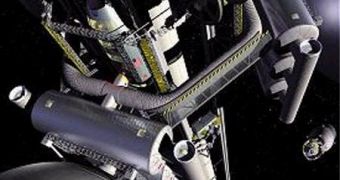Today, anybody or anything which must be transported into Earth's orbit is carried with the help of space rockets. Nonetheless, alternative space transportation devices such as space elevators, for example, could one day make space travel a whole lot faster, safer and cheaper than the conventional methods currently available. Albeit, space elevators have two fundamental flaws related to their building and operation.
First of all, there is no known material that has the required strength to sustain such a massive construction and secondly, they could suffer from potential dangerous vibrations that could disintegrate the space elevator if not attenuated. The first problem is not solved yet and will probably remain so for a very long time, however reducing dangerous vibrations may be more easily than anybody would ever think. Built-in thrusters could stabilize the elevator structure if vibrations reach dangerous levels.
Basically, the design of the space elevator is extremely simple. Stretch a cable from Earth all the way into space and you're done. The centrifugal force of the planet's rotation would keep the cable tensioned so that a second anchor is not required. The vehicle that must be deployed into space could either climb the tether - the cable - or power itself with laser beams or any other power source that would remove any conventional, expensive power sources.
Nanotubes could one day be used to construct a strong tether, as they have been demonstrated to have the required strength; however they must first be made into longer structures and to remove all the defects experienced in nanotube fabrication today.
Alternatives to thrusters
Gravitational interactions between the tether and the Moon or the Sun, or even solar wind pressure could induce violent vibration into the tether, effect that would make it to change course and intersect with orbits of satellites, space debris, thus endangering space traffic and the security of the elevator.
One of the alternative solutions to the use of thrusters to stabilize the tether would be to make the anchor on Earth movable, so that vibrations can be attenuated just by jiggling on the tether. However, Lubos Perek from the Czech Academy of Sciences' Astronomical Institute believes this solution would not be enough. "Previous proposals for a passive tether controlled from the ground do not seem stable to me," said Perek.
New Mexico Institute of Mining and Technology researcher Anders Jorgensen agrees. The stability of the space elevators is still a concern because he believes that the study conducted does not provide with a quantitative analysis of the situation. Jorgensen proposes instead that running electric current through the cable in order to create a magnetic field to interact with that of the Earth's magnetic field could weaken the vibrations, even though it would not eliminate them altogether. At least thrusters would not be required for such a job.
Thruster design problems
But if thrusters are indeed proven as a viable solution, they could be extremely hard to build into the tether. "I am sure that having thrusters hanging off the cable at regular intervals is going to be a serious annoyance in terms of maintenance, refueling, and simply the logics of attaching them and having the elevator bypass them," said Jorgensen.
Looking away from the problems related to the potential use of thrusters to stabilize the tether, Perek believes that it is still worth to build the space elevator. "Its possible advantages are enormous," he said. Nonetheless, more studies are required to determine how many of these thrusters would be required and where they would be positioned along the tether to keep it steady.

 14 DAY TRIAL //
14 DAY TRIAL //